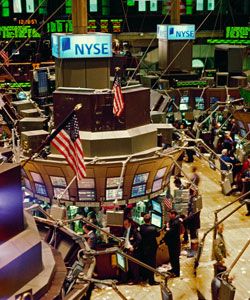Ever since the New York Stock Exchange began in 1792 with the historic Buttonwood Agreement, the United States has had a stock market. The Buttonwood Agreement was signed by 24 of our emerging country's most prominent bankers, brokers and merchants, all with the intent to trade stocks and securities through a common clearing house. These early stockbrokers looked to Europe for a model to build their system on and decided to base it on the system of Spain. This was largely due to the fact that the U.S. dollar's value had been based on the value of the Spanish real.
The real was the Spanish silver dollar and was divided into eight parts. This evolved from the method of counting on the hands, similar to the decimal system. The difference was that the decimal system used the thumbs as part of the number while this other system used the thumbs to denote the total of the four fingers. Therefore, a person would count to four on one hand and then use the thumb to indicate a total while they counted on the other hand. Two thumbs equaled eight. The real could be broken into two, four or eight parts, giving birth to the term pieces of eight.
Advertisement
So when the U.S. stock market began, they based the stock values on one-eighth fractions. An interesting side effect was the way this influenced the spread. The spread is the smallest amount that a stock can change in value. With one-eighth fractions, the smallest spread was 12.5 cents. This may seem insignificant, but it could amount to a large sum when trading thousands or even millions of shares of stock. Eventually, the stock exchanges added sixteenths to cut the spread to 6.25 cents. Today, there are even stocks that trade at thirty-seconds or sixty-fourths!
The problem with using fractions is that it has to be translated to match the rest of our decimal-based economy. For example, do you know how many shares of stock at 4 3/8 you can purchase for $4,375? You probably need a few moments with a calculator to realize that $4,375 will buy you 1,000 shares but it would have been fairly obvious in decimal form (4.375).
In 1997, the Common Cents Stock Pricing Act was signed to simplify the stock market by converting the fractions to decimal. This decimalization of the stock market began in August 2000 and will continue until all the stocks and markets are converted. Besides simplifying the market, decimalization will dramatically change the spread for many stocks with the potential to have a spread of just a penny (.01) under the new system.
For more information on stock decimalization and investing, check out the links on the next page.
Advertisement

